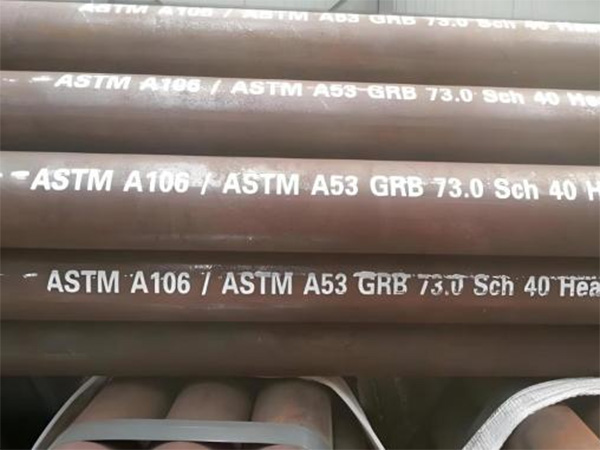ASTM A106 standard is specifically for
seamless carbon steel pipes for high-temperature services, while
ASTM A53 specification is the carbon steel pipe standard issued by ASTM International, including two types: seamless steel pipes and welded steel pipes. ASTM A106 and ASTM A53 steel pipes have obvious differences in manufacturing methods, types, grades, applications, etc. Below, I will give you a detailed introduction.
1. Differences in manufacturing methods
The manufacturing methods are mainly divided into welding and seamless manufacturing. A53 steel pipes allow three manufacturing types: Type F (furnace welding), Type E (resistance welding), and Type S (seamless), and each type has a different manufacturing method. However, A106 standard steel pipes are only manufactured in seamless, cold rolling, and hot rolling processes. It is often said in the industry that "A53 can be seamless or welded, while A106 can only be seamless."

2. Different types and grades
ASTM A53 standard has three manufacturing types: Type F (furnace welding), Type E (resistance welding), and Type S (seamless). These three types cover Class A and Class B.
Type A53 F - furnace butt-welded (continuous welding) : only for Grade A.
Type A53E - Electric-resistance welded (ERW) : can be Grade A or Grade B.
A53S type - seamless: It can also be Grade A or Grade B.
Grade description
Grade A: Carbon content ≤ 0.25%, manganese ≤ 0.95%; The minimum tensile strength is approximately 48,000 psi (≈ 330 MPa), and the minimum yield strength is approximately 30,000 psi (≈ 205 MPa).
Grade B: Carbon content ≤ 0.30%, manganese ≤ 1.20%; The minimum tensile strength is approximately 60,000 psi (≈ 415 MPa), and the minimum yield strength is approximately 35,000 psi (≈ 240 MPa).
ASTM A106 standard only allows seamless tubes (Type S), and there are three grades in total:
Grade A: carbon ≤ 0.25%, manganese 0.27-0.93%; The minimum tensile strength is ≈ 48,000 psi (≈ 330 MPa), and the yield strength is ≈ 30,000 psi (≈ 205 MPa).
Grade B: carbon ≤ 0.30%, manganese 0.29-1.06%; Silicon (Si) ≥ 0.10%, P/S ≤ 0.035%; The minimum tensile strength is ≈ 60,000 psi (≈ 415 MPa), and the yield strength is ≈ 35,000 psi (≈ 240 MPa).
Grade C: carbon ≤ 0.35%, manganese 0.29-1.06%; Other element restrictions are the same as those of Grade B; The minimum tensile strength is ≈ 70,000 psi (≈ 485 MPa), and the yield strength is ≈ 40,000 psi (≈ 275 MPa).
In the ASTM A106 standard, Grade B is the most commonly used grade and is widely applied in various applications.
3. Differences in chemical composition
The chemical composition of ASTM A53 includes carbon, manganese, phosphorus, sulfur, copper, nickel, chromium, molybdenum and vanadium. The maximum carbon content of Grade A is 0.25% (up to 0.3% for Type F), and that of Grade B is 0.3%.
The chemical composition requirements of ASTM A106 are stricter, and the allowable contents of elements such as phosphorus and sulfur are relatively low. There are specific limits on the content of carbon and manganese.
Chemical Composition Differences Among A106 B, A53 B
|
Standard and Grade
|
C
|
Mn
|
P
|
S
|
Si
|
Cr
|
Cu
|
Ni
|
Mo
|
V
|
|
ASTM A106 Grade B
|
0.30 Mx.
|
0.29-1.06
|
0.035 Mx.
|
0.035 Mx.
|
0.10 Min.
|
0.40 Mx.
|
0.40 Mx.
|
0.40 Mx.
|
0.15 Mx.
|
0.08 Mx.
|
|
ASTM A53 Grade B
|
0.30 Mx.
|
1.2 Mx.
|
0.050 Mx.
|
0.045 Mx.
|
-
|
0.40 Mx.
|
0.40 Mx.
|
0.40 Mx.
|
0.15 Mx.
|
0.08 Mx.
|
4. Differences in application fields
ASTM A53: Suitable for mechanical and pressure systems with low to medium pressure, it is often used for the transportation of steam, water, air and oil, and is also widely used as structural steel. It can be hot-dip galvanized or black steel pipe.
ASTM A106: Specifically designed for high-temperature and high-pressure applications (up to approximately 750 °F / ≈ 400 °C), it is commonly found in petrochemical, power generation and high-pressure process piping systems.
How to correctly choose ASTM A53 and ASTM A106 steel pipes?
If the project involves high-temperature and high-pressure environments (such as energy, petrochemical), it is recommended to choose ASTM A106 seamless steel pipes, especially Grade B or C;
If it is only for general low and medium temperature, low pressure piping or structural purposes and the budget is sensitive, ASTM A53 offers a more economical option;
If a special hydrogen-resistant environment is required, strict tolerances are needed, or higher strength may be needed for future expansion, A106 or dual certification (A53/A106) can be considered.
Read more:ASTM A106 pipe or Production process of A53 steel pipe
